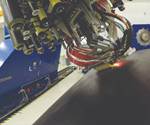TU Delft, KLM develop sustainable, long-distance aircraft
The “Flying-V” is designed for more efficient long-distance flight, incorporating an aerodynamic “v” shape.
.jpg;maxWidth=720)
Source | Edwin Wallet, OSO Studio, via TU Delft
Delft University of Technology (TU Delft; Delft, Netherlands) and KLM Royal Dutch Airlines (Amstelveen, Netherlands) have partnered for research into more sustainable aviation. They will be collaborating on TU Delft’s flight concept known as the “Flying-V,” designed for sustainable, long-distance flight.
.jpg;maxWidth=400)
Source | Edwin Wallet, OSO Studio, via TU Delft
The aircraft’s v-shaped design will integrate the passenger cabin, the cargo hold and the fuel tanks in the wings. Its improved aerodynamic shape and reduced weight reportedly will use 20% less fuel than the Airbus A350. A flying scale model and a full-size section of the interior of the Flying-V will be officially presented at the KLM Experience Days at Amsterdam Airport Schiphol in October on the occasion of KLM’s 100th anniversary.
According to TU Delft, the Flying-V will not be as long as the A350 but will have the same wingspan, enabling it to use existing infrastructure at airports, such as gates and runways, and to fit into the same hangar as the A350. The Flying-V reportedly will also carry the same number of passengers as the A350 – 314 in the standard configuration – and the same volume of cargo, 160 cubic meters. The Flying-V will be smaller than the A350, giving it less aerodynamic resistance.
“Our ultimate aim is one of emission-free flight. Our cooperation with KLM offers a tremendous opportunity to bring about real change,” says Henri Werij, dean of the faculty of aerospace engineering at TU Delft.
The Flying-V is also said to provide researchers an opportunity to improve passenger experience in aircraft, from the seating layout in the wings, to the design of the seats and bathrooms, while keeping everything as lightweight as possible to maximize efficiency. The current design for the turbofan engine runs on kerosene, but TU Delft says it can be adapted for new propulsion innovations such as electrically-boosted turbofans.
“We are proud of our progressive cooperative relationship with TU Delft, which ties in well with KLM’s strategy and serves as an important milestone for us on the road to scaling-up sustainable aviation,” says Pieter Elbers, KLM president and CEO.
“We are incredibly pleased to be able to cooperate with our trusted partner KLM on our combined mission to make aviation more sustainable,” says Werij. “Radically new and highly energy-efficient aircraft designs such as the Flying-V are important in this respect, as are new forms of propulsion.”
Related Content
-
Novel composite technology replaces welded joints in tubular structures
The Tree Composites TC-joint replaces traditional welding in jacket foundations for offshore wind turbine generator applications, advancing the world’s quest for fast, sustainable energy deployment.
-
ASCEND program update: Designing next-gen, high-rate auto and aerospace composites
GKN Aerospace, McLaren Automotive and U.K.-based partners share goals and progress aiming at high-rate, Industry 4.0-enabled, sustainable materials and processes.
-
Microwave heating for more sustainable carbon fiber
Skeptics say it won’t work — Osaka-based Microwave Chemical Co. says it already has — and continues to advance its simulation-based technology to slash energy use and emissions in manufacturing.

.jpg;width=70;height=70;mode=crop)













